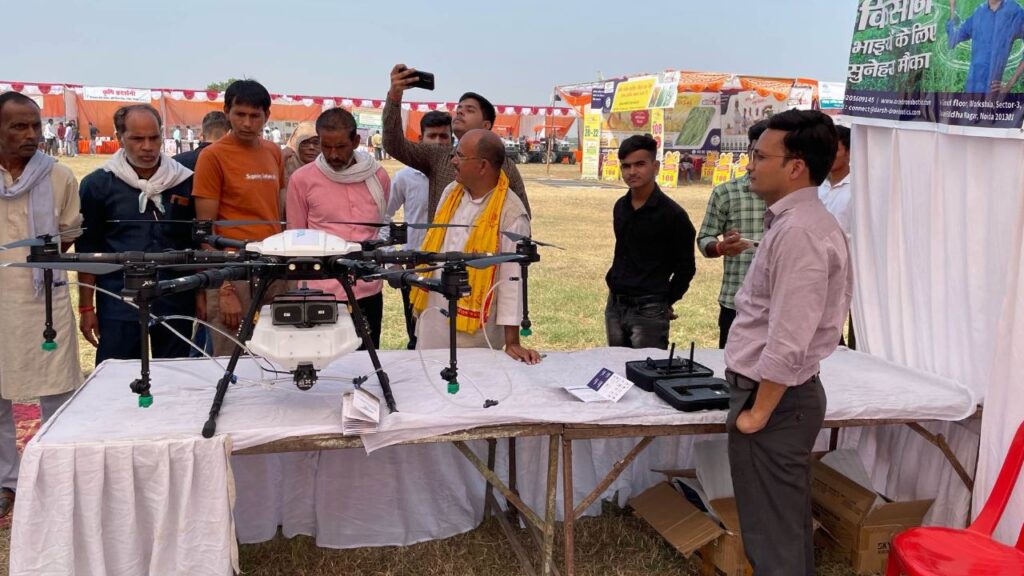SkyGuardian Drones, also recognized as Darsh Dronobotics Systems Pvt. Ltd., stands at the forefront of drone manufacturing in India, specializing in both defense and agriculture. It has established itself as a trusted ally, providing technological solutions and consultations across diverse industries.
The company addresses drone requirements in powerline, infrastructure, renewables, mining, agriculture, forest survey, and the defense sector. Moreover, SkyGuardian Drones aims to train 10 million young individuals to navigate the Industry 4.0 revolution.
From “dust and dirt” to “drone and dignity,” SkyGuardian Drones positions India as a global drone superpower. Talking to The Interview World, Ratandeep Tripathi, the Co-founder and CEO of SkyGuardian Drones emphasizes the company’s pivotal role in delivering cutting-edge DroneTech solutions across various sectors. The following excerpts provide insights from his interview.
Q: With the rapid evolution of drone technology, can you highlight some of the most promising and cutting-edge advancements that your company is currently exploring or implementing?
A: Rapid advancements in drone technology include the creation of cost-effective agriculture drones with extended endurance, emphasizing affordability and a 30-minute flight time. The “Kishan DOST (Drone Operations Support Team) Centre” plays a crucial role in providing farmers with knowledge, tools, and support for integrating drones into crop management, offering services like agriculture drone spraying and maintenance. Simultaneously, cutting-edge R&D and manufacturing facilities are in place for defense drones, incorporating 5G and 6G AI technology to meet defense operational needs.
Another significant initiative is the nationwide Center of Excellence (COE) on Drone Technology, focusing on skill development and DGCA-certified flying training for farmers. Additionally, the development of drone taxis aims to revolutionize urban transport, contingent on careful planning, technological advancements, and regulatory compliance. Collectively, these advancements underscore the growing potential of drones across industries, with ongoing research refining technologies for enhanced efficiency, safety, and broader applications.
Q: Can you share some specific products where your drones have demonstrated significant advantages, especially in sectors like defense, agriculture, surveillance, or infrastructure?
A: Our drones offer notable benefits, particularly in key sectors such as defense, agriculture, surveillance, and infrastructure. Within our lineup, we’ve introduced several specialized models to cater to diverse needs.
Firstly, our Agriculture Drone, the Kishan Mitra-II, boasts an extended endurance of up to 30 minutes, making it a reliable choice for agricultural applications. Moving into the realm of defense, our Kamikaze Attack Drones provide a cutting-edge solution, enhancing military capabilities.
For enhanced surveillance, we’ve developed Tethered Surveillance Drones designed specifically for defense applications. Moreover, our Cargo Fixed UAV can carry a payload capacity of up to 10 kg, suitable for both defense and civil use cases.
Lastly, our Surveillance UAV stands out with an impressive endurance of 6 hours, making it an ideal choice for defense and police services. These diverse drone models showcase our commitment to delivering innovative solutions tailored to meet the unique demands of various sectors.
Q: How has the regulatory environment in India impacted the growth and innovation of your drone technology?
A: India’s drone technology has flourished, with the regulatory landscape playing a pivotal role in its evolution. The introduction of the 2021 Drone Rules marked a transformative moment, simplifying operations by categorizing drones by weight and implementing digital permitting systems. This framework established guidelines for operations, remote pilot licenses, and No-Permission-No-Takeoff (NPNT) protocols to enhance safety. However, while prioritizing safety, these regulations initially posed challenges for innovation, hindering rapid experimentation. Compliance costs and NPNT requirements further created entry barriers for smaller innovators, limiting market access.
Despite the challenges, the regulatory environment spurred opportunities for innovation, fostering developments in Geo-fencing, remote identification systems, and compliance software. As drone companies adapted and technologies matured, the regulatory environment demonstrated adaptability through amendments. These changes aimed to strike a balance between safety and fostering innovation. The demand for licensed remote pilots led to skill development initiatives, cultivating a proficient workforce in drone operations and regulatory compliance.
Q: How is your company leveraging emerging technologies like AI, ML, and Big Data to improve the performance, autonomy, and safety of your drones?
A: Our Agriculture Drones, equipped with advanced AI and ML algorithms, revolutionize agriculture by analyzing data from sensors and cameras. This data insightfully informs crop health, pest detection, and yield predictions, optimizing farming practices. Autonomous navigation, enabled by AI and ML, empowers drones to make real-time decisions on flight paths, obstacle avoidance, and route planning independently. Using computer vision techniques, our drones detect and recognize objects for applications like surveillance and search and rescue.
Big Data analytics predict maintenance needs, reducing downtime and enhancing system reliability. AI algorithms in our drones process real-time weather data for adaptability in challenging conditions. Security features like facial recognition and Geo-fencing prevent unauthorized flights, ensuring sensitive areas’ safety. Moreover, AI-powered tools aid regulatory compliance, automatically enforcing no-fly zones. ML algorithms optimize energy consumption, improving overall operational efficiency and extending flight times.
Q: Are there any national or international collaborations or expansion plans that contribute to your growth?
A: We actively foster global collaborations between US-based drone companies and South Korea-based defense firms, aiming to leverage international expertise, share technologies, and explore new markets. These collaborations may manifest as joint ventures, technology partnerships, or strategic alliances. Simultaneously, our focus on government partnerships involves establishing a Center of Excellence (COE) for Drone Technologies, collaborating with government agencies for regulatory compliance, research, and drone integration into national airspace.
In the realm of research and development, we engage with IITs/NITs and agricultural universities to drive innovation, enhance technology, and discover new drone applications. As drone manufacturers, our expansion strategy targets emerging markets, involving the setup of manufacturing facilities, robust distribution networks, and local partnerships. Additionally, we actively seek technology transfer and licensing agreements, allowing us to access specific overseas technologies and expertise, fostering continuous innovation and growth in our drone manufacturing endeavors.
Q: Are there particular trends or developments you foresee shaping the landscape of drone technology in the coming years?
A: The landscape of drone technology is changing significantly in various domains. In urban air mobility (UAM), we are actively developing drone taxis for intra-city transportation, promising a revolutionary shift in commuting within densely populated areas. Additionally, our commitment to affordable agricultural solutions includes the creation of cost-effective drones with extended endurance for crop spraying services. The expansion of drone usage in delivery services, especially in remote areas, is underway, driven by advancements in regulations and technology.
Drones can play a pivotal role in environmental monitoring, wildlife conservation, disaster management, healthcare, and emergency services. Integrating advanced sensors like LiDAR and hyperspectral imaging enhances drone capabilities for precision in agriculture, infrastructure inspection, and environmental monitoring. Simultaneously, the proliferation of drones necessitates the development of counter-drone technologies to address security risks from unauthorized flights. The future holds transformative potential for drone technology across urban mobility, agriculture, delivery, environmental conservation, healthcare, and security.



